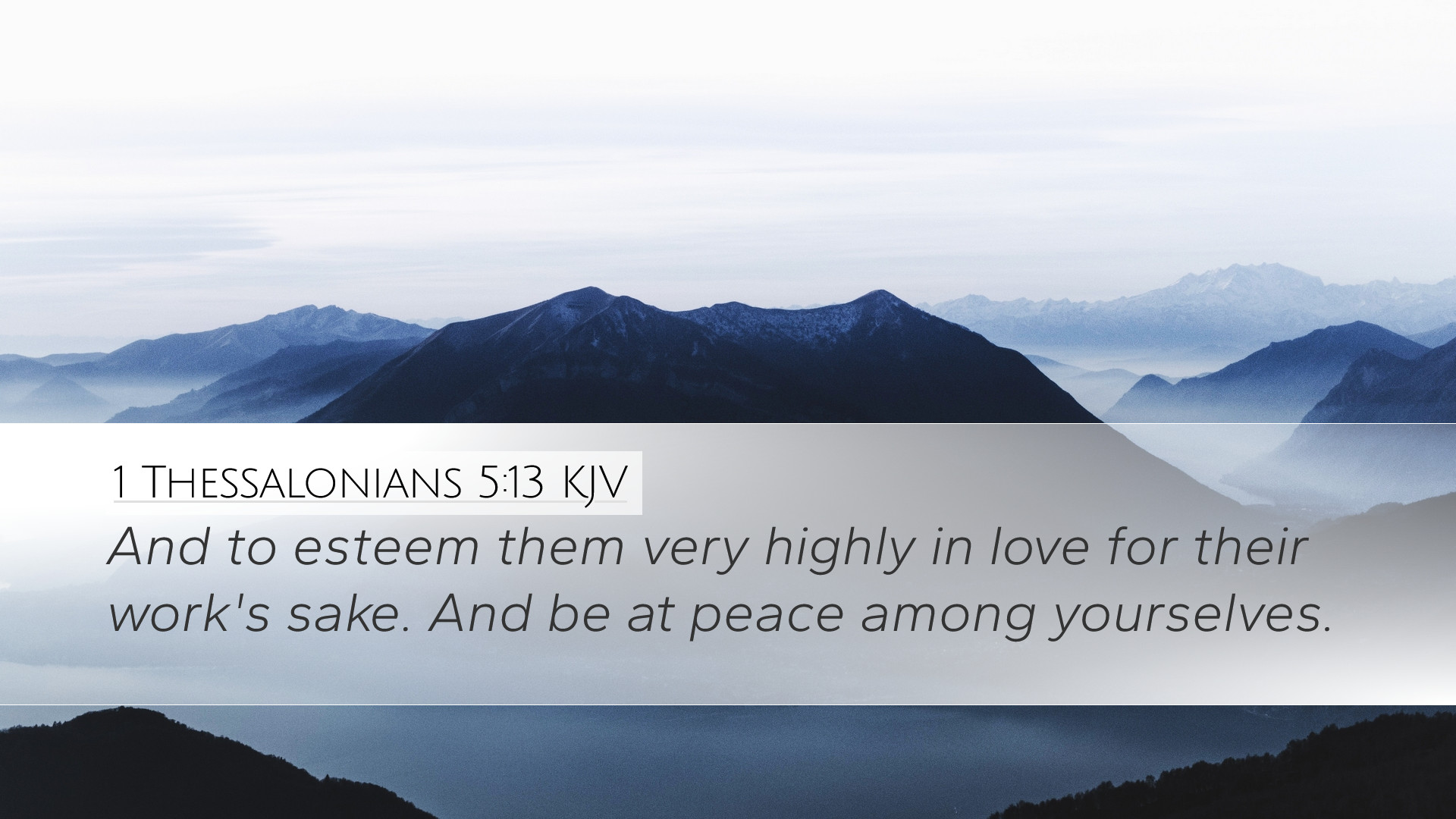Commentary on 1 Thessalonians 5:13
In 1 Thessalonians 5:13, the Apostle Paul instructs the believers in Thessalonica to "be at peace among yourselves." This brief yet profound exhortation encapsulates a significant portion of Christian instruction regarding community life and interpersonal relationships within the body of Christ. By examining this verse through the insights provided by public domain commentaries, we can uncover deeper theological and practical implications for the church.
Contextual Background
Paul's first letter to the Thessalonians is one of the earliest writings in the New Testament and addresses a young church that is enthusiastic yet facing persecution and anxiety about their faith and the return of Christ. A primary theme throughout this epistle is encouragement. Paul encourages the believers to stand firm in their faith, to cultivate love for one another, and to live in anticipation of the Lord's return.
In the latter part of the epistle, Paul offers practical exhortations for Christian living, which includes the instruction to maintain peace among themselves. This particular phrase emphasizes the necessity of unity and harmony within the church community, a theme echoed throughout his letters.
Analysis of the Exhortation
1. The Importance of Mutual Peace:
Matthew Henry highlights that peace is an essential aspect of human relationships, particularly within the church. He notes that unity is paramount, as division can leave the community vulnerable to external adversities and internal strife. When believers are at peace with one another, they reflect the nature of Christ and provide a powerful witness to the world.
2. Peace as a Fruit of the Spirit:
Albert Barnes connects this exhortation to the broader teaching of the New Testament concerning the fruits of the Spirit (Galatians 5:22-23). He emphasizes that peace among believers is not merely the absence of conflict but a multitude of rich interactions marked by love, understanding, and mutual support. When believers are grounded in the Spirit, they flourish in peaceful relationships.
3. Practical Steps Towards Peace:
Adam Clarke draws attention to the practical aspects of cultivating peace in a community. He suggests that this involves active engagement in reconciliation, a commitment to love others unconditionally, and a willingness to forgive. Clarke cites the necessity of addressing grievances openly and following the principles laid out by Jesus in Matthew 18 regarding confrontation and resolution in a spirit of grace and humility.
Theological Implications
1. Theological Unity:
The call to be at peace among ourselves also has a theological dimension. As noted by Matthew Henry, this appeal reflects the unity of the Trinity, which believers are called to emulate. Thus, the peace amongst believers is a reflection of their relationship with God, who is himself the author of peace (1 Corinthians 14:33).
2. The Role of the Church:
Albert Barnes further interprets this verse in the context of the church as the body of Christ. He suggests that peace enables the church to function effectively. When believers are in harmony, they can achieve their mission of sharing the Gospel more effectively and embodying the teachings of Christ in their actions.
3. Eschatological Hope:
Adam Clarke connects this exhortation to the church’s anticipation of the second coming of Christ. He posits that living in peace serves as preparation for that day; unresolved conflicts and discord can hinder spiritual readiness and diminish witness to the returning King. Encouragement to maintain peace is, therefore, a vital component in the roadmap to holy living.
Practical Applications for the Church
1. Cultivating a Culture of Peace:
Pastors and church leaders should intentionally foster an environment where peace prevails. This can involve teaching on conflict resolution, promoting forgiveness, and encouraging accountability among members. As highlighted by Matthew Henry, the church should model love in action, providing a sanctuary where everyone can thrive spiritually and relationally.
2. Engaging in Community Initiatives:
Engaging in community service within and outside the church can also be a fruitful way to promote peace. By working together, congregants not only strengthen their bonds but also demonstrate the love of Christ in practical ways. Albert Barnes suggests that such collaboration helps believers to remain focused on their shared mission rather than personal differences.
3. Conflict as an Opportunity for Growth:
When conflicts arise, they should be regarded as opportunities for spiritual growth. Adam Clarke encourages believers to view disagreements as chances to deepen understanding and compassion. By following biblical principles for reconciliation, believers can turn strife into a testimony of God’s redemptive power in their lives.
Conclusion
1 Thessalonians 5:13 is a rich and meaningful instruction that calls the church to embody peace. It's a message of hope and an exhortation to reflect the character of Christ through harmonious relationships. As we impart these truths to our communities, we must remember the deep theological foundations evident in this scripture—our peace with one another is rooted in our peace with God. Let this peace thrive among us, for in it lies our witness to a world in desperate need of unity and love.


